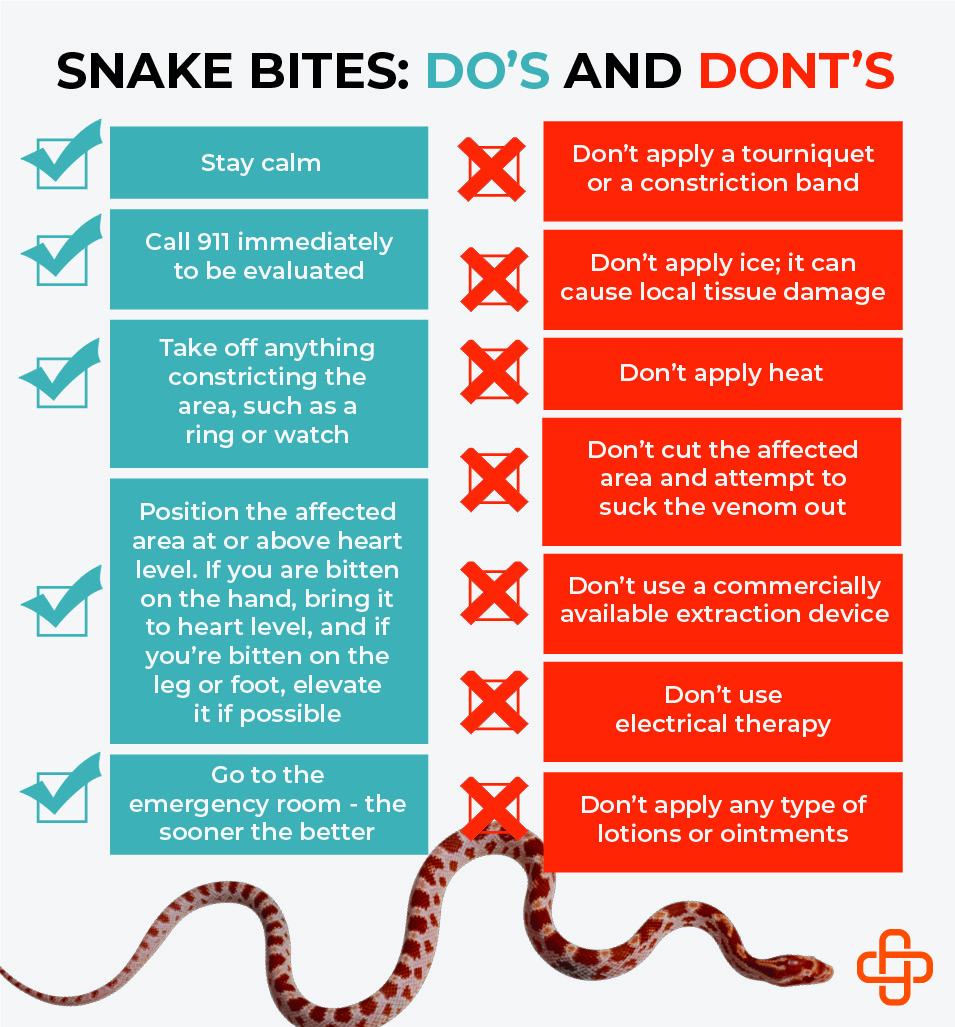As we wave goodbye to Mr. Winter and welcome the warm sunny days of spring and summer, there is one safety topic that quickly becomes top of mind – snake bite injuries!
Do you know what types of snakes pose the biggest danger? What about steps to take if an employee sustains a bite? Join us as we “coil” through the ins and outs of all things snake bites and provide answers to the number one question everybody wants to know (hint – keep reading to the bottom)!
Are All Snake Bites Dangerous?
Did you know there are approximately 300 species of snakes native to the United States? Thankfully, only 10% are actually venomous.
Between 5,000 – 10,000 people are bitten by venomous snakes annually, typically between April and October. Death is extremely rare and occurs in fewer than 1% of cases. Many bites, however, do cause significant pain and disability.
There are 2 types of venomous snakes native to the U.S.
1. Pit vipers include rattlesnakes, copperheads, and cottonmouths. Pit vipers account for more than 95% of all venomous bites reported to U.S. Poison Centers.
2. Coral snakes account for fewer than 5% of bites.
Not all bites from venomous snakes result in envenomation (when venom is injected into a person’s body). A “dry bite” means that no venom was introduced and may occur up to 25% of the time following pit viper bites and up to 60% of the time following a bite from a coral snake.
What Should You Expect After Being Bitten By a Snake?
If there is an envenomation, pain is almost always present. Pit viper bites are also characterized by significant swelling and bruising, though it may take several hours for these to peak. Other signs of a pit viper bite may include:
- Bloody wound discharge
- Excessive sweating
- Nausea or vomiting
- Weakness, dizziness, or fainting
- Difficulty swallowing
- Numbness and tingling, especially in the mouth
- Fang marks in the skin
- Enlarged lymph nodes in the area
- Generalized bleeding or hemorrhage
- Shock
Coral snake bites cause pain, but do not produce significant tissue damage or bruising.
Signs of a coral snake envenomation may include:
- Nausea or vomiting
- Excessive sweating
- Weakness, dizziness, or fainting
- Difficulty swallowing
- Numbness and tingling, especially in the mouth
- Difficulty breathing
- Double vision
What Should You Do To Treat a Snakebite?
It shouldn’t come as a surprise that there are a lot of myths regarding how to treat snake bite injuries. Many of such myths, once believed to be helpful, have been proven to be ineffective and possibly dangerous.
If you are caring for an employee who has been bitten by a rattlesnake, copperhead, or cottonmouth, you should do all of the following:
- Get yourself and the employee to a safe place away from the snake
- Call 911 and have the employee transported to an emergency department
- Remove jewelry and constrictive clothing on the affected extremity
- Have the employee lie down and help keep him or her calm
- Do not allow the employee to eat or drink
- Keep the employee warm, but do not apply heat to the bite itself
- Monitor the employee’s heart rate and breathing
- Gently wash the area – but do not delay transport to do this
- Elevate the affected extremity above heart level. Though the opposite was previously recommended, it is now known that local damage is a much greater concern than systemic illness, especially following bites from pit vipers in Southeast Texas. Elevating the extremity minimizes the amount of swelling and tissue damage and decreases the likelihood of permanent disability.
- Avoid applying ice to the bite – this increases the amount of local tissue damage
- Avoid commercially-made suction devices since these do not remove venom and actually increase tissue damage
- Avoid cutting into the bite and applying suction; this does not remove venom and actually worsens the wound and increases the likelihood of infection
- Do not apply a tourniquet or a constriction band
Treatment for a coral snake is the same except, in this situation, the affected extremity should be kept below heart level.
It is helpful if you can identify the type of snake, but it is never necessary to put yourself at risk trying to capture or photograph the snake. Ultimately the physician can determine clinically if there is an envenomation and whether it is due to a pit viper or coral snake.
Once the employee has arrived at the hospital, he or she will receive any needed supportive care and analgesia to assist with pain control. An expert should be consulted to determine the need for anti-venom, which can directly neutralize the snake venom.
Anti-venom is most effective if started within the first 6 hours after the envenomation, but still provides a benefits if started at 24 or even 48 hours after the bite.
Looking for a quick reference to educate employees? Utilize this Snake Bite – Do’s and Dont’s Guide

The Most Frequently Asked Question
Each year Axiom receives numerous calls from clients asking, “Which treatment facilities stock anti-venom?”.
The reality is that you never know as availability frequently changes. Due to the limited supply which quickly outdates, anti-venom is commonly stored at central locations and can be distributed to an emergency facility when needed.
The key takeaway and what you want to remind staff of is to seek treatment as soon as possible. You never want to drive past a closer emergency facility, believing a larger treatment center at a greater distance will have anti-venom.
Should you need assistance with a snake bite injury, Axiom’s Nurse Case Managers are available 24/7 to care for the injured worker and will facilitate their return to work.

Holly is an ER nurse by trade, but loves content marketing. She was born outside the box and believes everything is better with “sprinkles and sparkles”. She is passionate about impacting lives and uses marketing as her platform for sharing practical solutions to address real life occupational health challenges.
Find out more about our Injury Case Management services or our Occupational Health Programs.










